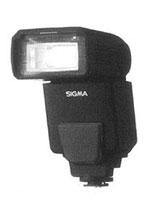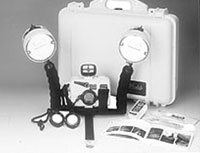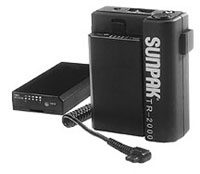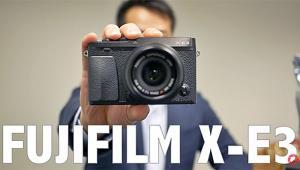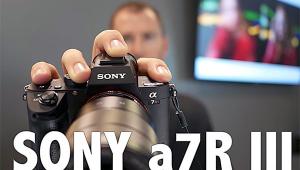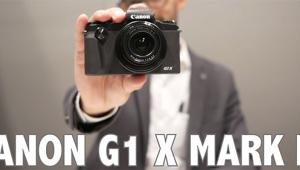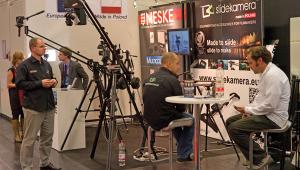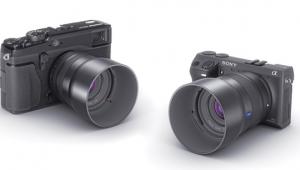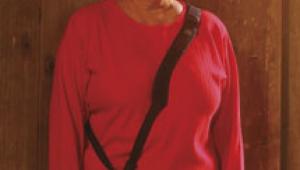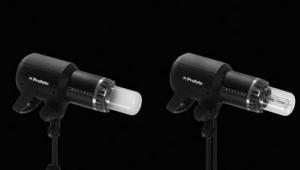Electronic Flash Units And Batteries
As camera manufacturers introduce new SLRs, they also tend to announce new flash units. As well, several independent brand flash manufacturers showed new models at photokina with additional functions. Most of the products that we found were upgrades to existing models as were the new battery types. Some of the batteries can be used in equipment other than flashes of course, but it seemed logical to include them here. Eveready Energizer. Already well-known for the only line of lithium AA batteries, the Energizer brand has a new look and name: Energizer e2 Photo Lithium. Available in various formats, these improved "super premium" silver colored batteries promise 35 percent longer life and faster flash recycling. Shelf life is now a full 10 years. Energizer also showed a new line of Ni-MH batteries, rechargeable up to 1000 times, without any memory effect. Called ACCU Rechargeable Hi Energy, these will be available in the AA (1600 mAh) format required by SLR cameras and many flash units. The advantages of Ni-MH batteries are already well-known, including excellent cold weather performance and very quick flash recycle. Energizer literature claims that "denser chemistry stores up to 125 percent more power than an equivalent NiCd battery." The conventional Energizer alkaline batteries have also been improved. The new Intelligent models promise "optimal performance and efficiency€lasting up to two times as long as ordinary alkalines." |
|
Kodak. As mentioned in my report on SLR cameras and lenses, The Tiffen Company now distributes a new line of photographic accessories called Kodak Gear. This line includes a couple of flash units but specification sheets were not yet available at the time of this writing. However, Eastman Kodak did show us some of their new Photolife Lithium batteries in various formats for compact and digital cameras. These offer a significant improvement over earlier models: roughly a 25 percent increase in recycle time with a camera's built-in flash unit. The press kit also mentions "up to 50 percent more flashes." Superior cold weather performance is also indicated, with much longer life around zero degrees, great for outdoor photography in the winter. For additional information, visit their web site at: www.kodak.com/go/batteries. |
|
Metz. Since Metz flash units are manufactured in Germany, this brand is the most popular in that country. Readily available in the US, too, these flash units offer sophisticated technology and adapter modules for numerous cameras from APS to 35mm to medium format. Three new models were unveiled at photokina. First is the Mecablitz 54MZ-3, a 24-105mm zoom flash with a GN of 177, in feet. This is the first Metz model that supports high-speed synch, and offers a greatly simplified operating concept. This unit has only two function buttons and a single dial for quick and convenient operation, plus an LCD data panel. This model comes with a standard foot or as a set with the SCA-3002 adapter for Canon, Minolta, Nikon, and Pentax cameras. It will support the E-TTL flash system of some EOS cameras as well as 3D multi-sensor flash with Nikon bodies with the necessary pre-flashes. (Naturally, the new Metz models are also compatible with the SCA-300 adapter as well.) The 54MZ-3 sits high above the lens axis, reducing the redeye effect in low-light people photography. It also offers swivel and tilt capability, second-curtain synch setting, flash exposure compensation and bracketing control, and features stroboscopic and modeling light settings, too. This unit is also compatible with the wide range of Metz accessories, including the Power Pack P40 and P50. For even higher power, the new Mecablitz 70 MZ-5 would be a fine choice, with a GN of 230 providing lots of output. This pro, handle mount unit also features the same, simplified controls, and compatibility with the same cameras using the pertinent adapter. A successor to the Mecablitz 50 MZ-5, this new model includes all 54MZ-3 capabilities plus integrated slave function; a secondary small flash head; wide angle diffuser for 20mm coverage; program memory for frequently used settings; and a rapid mode for quick shooting of a series of images. The LCD display size has been increased and can be illuminated. Both second curtain synch and flash exposure compensation can be set on the flash unit itself, instead of the SCA adapter. We also checked out a third Metz model, the Mecablitz 70 MZ-4, the smaller counterpart of the MZ-5. Some pro features have been omitted to reduce the price but this model still offers TTL exposure measurement (including Nikon 3D) and fill-in flash. The capabilities that have been omitted are as follows: secondary flash; stroboscopic and rapid flash mode; integrated slave function; flash bracketing; and the key function. Note that the new SCA-3002 adapter system allows for digital data exchange between the camera and flash unit permitting the new capabilities mentioned in this report. The SCA-3002 can be used with any Metz flash unit that was designed for use with the SCA-3000 or SCA-300 system. Minolta. Announced concurrently with their Maxxum 7 camera, the two new flash units can be used with any Maxxum body. However, the Program Flash 5600HS (D) or 3600HS (D) would be the best choice with the Maxxum 7 for several reasons. First, they both offer highly reliable metering accuracy with the Advanced Distance Integration flash metering when the Maxxum 7 is used with one of the new D-series lenses. The AF illuminator of the 5600HS (D) covers the nine-point AF sensors of the Maxxum 7 while the 3600HS (D) provides coverage for the central three focus points of that camera. The 5600 model (GN 183, in feet) is a high power unit that supports wireless remote high-speed synch when used as an off-camera flash with the Maxxum 7. Naturally, both models feature many other capabilities suitable for use with other cameras, too. The flash head of the 5600HS (D) tilts down 10 for close-up photography. Both flash units support wireless off-camera TTL flash, ratio flash, high-speed synch, etc. The 5600 also offers manual flash control, multiple flash and modeling light options plus five Custom Functions to customize operation. The 3600 model (GN 118, in feet) has two Custom Functions and is a very compact unit. The new, slim and portable, External Battery Pack EP-2 can be used with either unit when extended battery life is important. |
|
Nissin. Although not as well known as some brands in the US, Nissin makes a broad line of compact flash units. At photokina, the rep from this Japanese manufacturer showed me several new models, starting with the Digislave. This one is intended for use with compact digital or film-based cameras that include a built-in flash. A slave model, it requires no connection to the camera but it can be mounted into a hot shoe or onto a flash bracket if desired. It's available in four colors: titanium, gold, blue, and black. A more conventional flash unit, available in models for most popular autofocus SLR cameras, the Nissin 32AF is a full-size TTL unit with a GN of 105, in feet. An AF assist beam assists focusing in low-light conditions and the head can be set for a wide or tele setting. For those who own Nissin flash units without the new AF assist illuminator, Nissin now offers an accessory Illumination and TTL autoexposure metering module. It's intended for use with Nissin 6000AF pro flash, the 3200AF mini-handle flash, or the M100AF macro-photo flash unit. Models are available for Canon, Minolta, and Nikon SLR cameras. |
|
Sigma. This lens manufacturer also makes an SLR camera and flash units with the two newest models being the Flash EF-500ST and EF-500 Super. Both are large, high power shoe-mount units with a GN of 165, in feet; compatible cameras include most popular brands of autofocus SLRs. Naturally, they feature the usual amenities: auto zoom head from 28-105mm coverage; built-in panel that allows for 17mm coverage; TTL exposure control; upward and downward tilt plus swivel capability; modeling flash; LCD data panel; and more. Sigma particularly emphasizes increased compatibility with new high tech cameras. Both models intended for Nikon support the cameras' 3D multi-sensor balanced fill flash function and the models for Canon support E-TTL pre-flash with the latest EOS cameras. This Super model also offers several other extras over the ST flash, available with most AF cameras. These include: multi-pulse flash feature from 1-199Hz plus reduced power setting from 1/4 to 1/128 in six steps; wireless off-camera TTL flash photography and slave flash photography; high-speed synch capability; manual flash that can be set at eight output levels. |
|
The major problem in underwater photography is a lack of light. While the amphibious compact cameras include a small built-in flash unit, higher power is often required. Since two flash units are better than one, SeaLife introduced the new ReefMaster MAXX Dual Strobe system at photokina. This system can be adjusted without the use of screws and the arms can be easily extended with the two (included) extension arms. This is a slave system so it is triggered by the camera's flash unit without the use of any connecting cables. The MAXX kit includes all the components required: including the two flash units, 3" extension kits, and more. By moving the flash far away from the lens axis, annoying backscatter can be avoided: small particles in the water are less likely to cause white spots to appear in the pictures. The MAXX kit is also available in a larger package including the new ReefMaster RC land/sea camera with removable housing, a 3x close-up filter, accessory case, and a special care kit. |
|
Sunpak. Distributed by Tocad America Inc. in the US, the Sunpak flash and accessory system was already vast. A new compact flash unit and high voltage battery pack introduced at photokina expand this line. The Digital Flash unit enhances the limited lighting capabilities of most digital cameras' built-in flash great in low-light photography. Naturally, this unit can also be used with conventional film-based cameras. The Digital Flash can be connected to the camera's hot shoe or to the PC cord socket; it can also be used as a wireless slave flash without any connection to the camera so it's suitable for point-and-shoot models, too. The Digital Flash features a 200 millisecond firing delay ensuring proper flash synch with digital cameras; with conventional cameras, flash synch to speeds up to 1/250 sec can be used. This is a tiny (2.5x2x3.75") unit in a distinctive platinum color finish with a GN of 52, in feet, and offers manual and autoexposure settings. A base stand and matching flexible mini tripod are also available, ideal for use when the flash unit is set for wireless slave flash. For use with more conventional flash units, Sunpak introduced their new TR-2000 Universal High Voltage Battery Pack System for Sunpak and other brands. High and low voltage ports are included via a battery compartment module. The TR-2000 will also accept power cords from other manufacturers' packs. Weighing under 1.5 lbs, (including the removable NiCd battery cluster) this is a relatively small unit at 6x5x2.5". It accepts the Sunpak NiCd or Ni-MH removable clusters and features a five level LED power indicator. The system also includes a high voltage battery pack, charger, and shoulder strap. Optional voltage connector cords for Sunpak flash units, additional battery clusters and chargers are also available. Vivitar. Best known for their rugged line of manual and non-TTL flash units still used by many pros, Vivitar also makes some high tech flash units. The most recent shown at photokina is the 850AF (GN 120, in feet) with power zoom head; full TTL auto capability; LCD data panel; power output settings of full, 1/2, 1/4, and 1/8; and a swivel and tilt head. This model can be used in fully automatic or manual mode and is said to be fully dedicated to Canon, Minolta, Nikon, and Pentax autofocus SLR cameras. Manufacturers/Distributors |
- Log in or register to post comments




